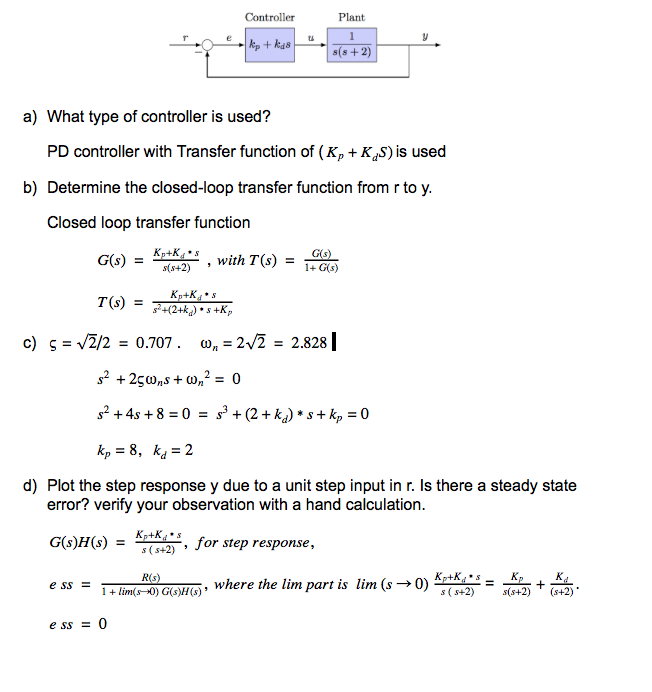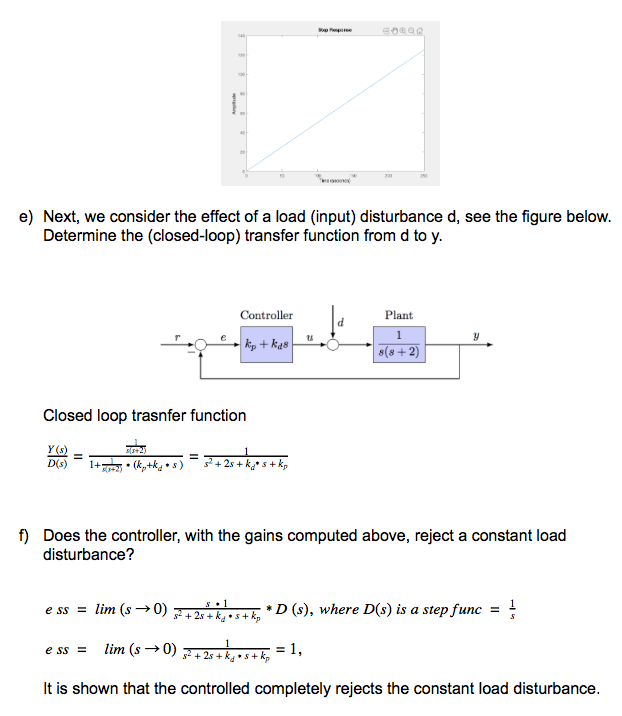Plant Controller 1 e kp+kas s(s+2) a) What type of controller is used? PD controller with Transfer function of (Kp+ K,S) is used b) Determine the closed-loop transfer function from r to y Closed loop transfer function Kp+K s s(s+2) G(s) 1+ G(s) with T(s) G(s) Kp+K s (2+k) .5+Kp T(s)= c) s 2/2 = 2/2 = 0.707 2.828 о, s225ns,2 = 0 24s8 0= s3+ (2+ k^)*s + kp = 0 kp 8, k4 = 2 d) Plot the step response y due to a unit step input in r. Is there a steady state error? verify your observation with a hand calculation Kp+K s s(s+2) G(s)H(s) for step response, Kp+K s s s+2) Ка (s+2) Кр s(s+2) R(s) 1lim(s0) G(s)H(s) where the lim part is lim (s ->0) e ss e ss 0 20 T e) Next, we consider the effect of a load (input) disturbance d, see the figure below Determine the (closed-loop) transfer function from d to y Controller Plant 1 kpkas S(8+2) Closed loop trasnfer function Y(s) 1+ s+k Ds) s 2s f) Does the controller, with the gains computed above, reject a constant load disturbance? *D (s), where D(s) is a step func e ss=lim (s ->0) +2sks k lim (s 0) 1, s+k e ss s22s+ It is shown that the controlled completely rejects the constant load disturbance.
Plant Controller 1 e kp+kas s(s+2) a) What type of controller is used? PD controller with Transfer function of (Kp+ K,S) is used b) Determine the closed-loop transfer function from r to y Closed loop transfer function Kp+K s s(s+2) G(s) 1+ G(s) with T(s) G(s) Kp+K s (2+k) .5+Kp T(s)= c) s 2/2 = 2/2 = 0.707 2.828 о, s225ns,2 = 0 24s8 0= s3+ (2+ k^)*s + kp = 0 kp 8, k4 = 2 d) Plot the step response y due to a unit step input in r. Is there a steady state error? verify your observation with a hand calculation Kp+K s s(s+2) G(s)H(s) for step response, Kp+K s s s+2) Ка (s+2) Кр s(s+2) R(s) 1lim(s0) G(s)H(s) where the lim part is lim (s ->0) e ss e ss 0 20 T e) Next, we consider the effect of a load (input) disturbance d, see the figure below Determine the (closed-loop) transfer function from d to y Controller Plant 1 kpkas S(8+2) Closed loop trasnfer function Y(s) 1+ s+k Ds) s 2s f) Does the controller, with the gains computed above, reject a constant load disturbance? *D (s), where D(s) is a step func e ss=lim (s ->0) +2sks k lim (s 0) 1, s+k e ss s22s+ It is shown that the controlled completely rejects the constant load disturbance.
Introductory Circuit Analysis (13th Edition)
13th Edition
ISBN:9780133923605
Author:Robert L. Boylestad
Publisher:Robert L. Boylestad
Chapter1: Introduction
Section: Chapter Questions
Problem 1P: Visit your local library (at school or home) and describe the extent to which it provides literature...
Related questions
Question
The previous solutions are posted on screenshot. please refer to them for gain value.
solve :
An integrator is added to the PD controller, leading to a PID controller C(s) = kp +ki/s + kds. Keep the PD controllers gains kp and kd from above, and plot the closed-loop poles as the gain ki varies from 0 ! 1 (Hint: The closed-loop poles satisfy 1 + P (s)C(s) = 0, translate this to Evan’s form 1 + kiG(s) = 0).
Determine gains such that a load disturbance is rejected in about 10 time units, while keeping the amount of overshoot (from r to y) under 20%. Why can ki not be too large?

Transcribed Image Text:Plant
Controller
1
e
kp+kas
s(s+2)
a) What type of controller is used?
PD controller with Transfer function of (Kp+ K,S) is used
b) Determine the closed-loop transfer function from r to y
Closed loop transfer function
Kp+K s
s(s+2)
G(s)
1+ G(s)
with T(s)
G(s)
Kp+K s
(2+k) .5+Kp
T(s)=
c) s 2/2
= 2/2
= 0.707
2.828
о,
s225ns,2 = 0
24s8 0= s3+ (2+ k^)*s + kp = 0
kp 8, k4 = 2
d) Plot the step response y due to a unit step input in r. Is there a steady state
error? verify your observation with a hand calculation
Kp+K s
s(s+2)
G(s)H(s)
for step response,
Kp+K s
s s+2)
Ка
(s+2)
Кр
s(s+2)
R(s)
1lim(s0) G(s)H(s)
where the lim part is lim (s ->0)
e ss
e ss 0

Transcribed Image Text:20
T
e) Next, we consider the effect of a load (input) disturbance d, see the figure below
Determine the (closed-loop) transfer function from d to y
Controller
Plant
1
kpkas
S(8+2)
Closed loop trasnfer function
Y(s)
1+
s+k
Ds)
s 2s
f)
Does the controller, with the gains computed above, reject a constant load
disturbance?
*D (s), where D(s) is a step func
e ss=lim (s ->0)
+2sks k
lim (s 0)
1,
s+k
e ss
s22s+
It is shown that the controlled completely rejects the constant load disturbance.
Expert Solution
This question has been solved!
Explore an expertly crafted, step-by-step solution for a thorough understanding of key concepts.
This is a popular solution!
Trending now
This is a popular solution!
Step by step
Solved in 8 steps with 8 images

Knowledge Booster
Learn more about
Need a deep-dive on the concept behind this application? Look no further. Learn more about this topic, electrical-engineering and related others by exploring similar questions and additional content below.Recommended textbooks for you

Introductory Circuit Analysis (13th Edition)
Electrical Engineering
ISBN:
9780133923605
Author:
Robert L. Boylestad
Publisher:
PEARSON

Delmar's Standard Textbook Of Electricity
Electrical Engineering
ISBN:
9781337900348
Author:
Stephen L. Herman
Publisher:
Cengage Learning

Programmable Logic Controllers
Electrical Engineering
ISBN:
9780073373843
Author:
Frank D. Petruzella
Publisher:
McGraw-Hill Education

Introductory Circuit Analysis (13th Edition)
Electrical Engineering
ISBN:
9780133923605
Author:
Robert L. Boylestad
Publisher:
PEARSON

Delmar's Standard Textbook Of Electricity
Electrical Engineering
ISBN:
9781337900348
Author:
Stephen L. Herman
Publisher:
Cengage Learning

Programmable Logic Controllers
Electrical Engineering
ISBN:
9780073373843
Author:
Frank D. Petruzella
Publisher:
McGraw-Hill Education

Fundamentals of Electric Circuits
Electrical Engineering
ISBN:
9780078028229
Author:
Charles K Alexander, Matthew Sadiku
Publisher:
McGraw-Hill Education

Electric Circuits. (11th Edition)
Electrical Engineering
ISBN:
9780134746968
Author:
James W. Nilsson, Susan Riedel
Publisher:
PEARSON

Engineering Electromagnetics
Electrical Engineering
ISBN:
9780078028151
Author:
Hayt, William H. (william Hart), Jr, BUCK, John A.
Publisher:
Mcgraw-hill Education,